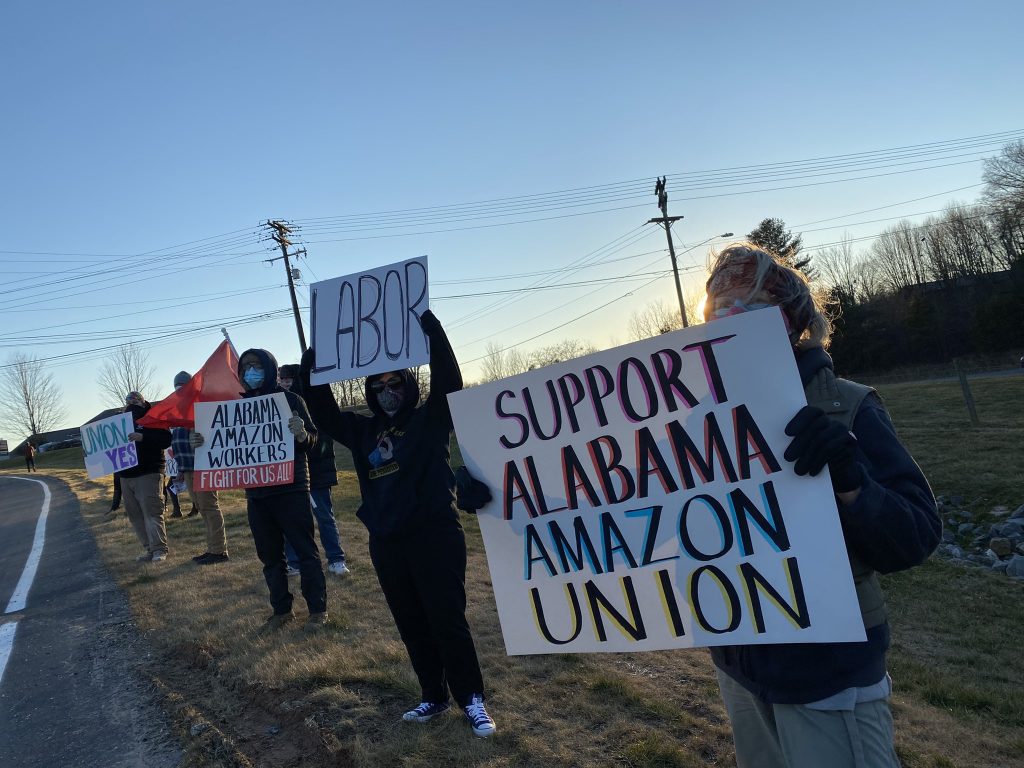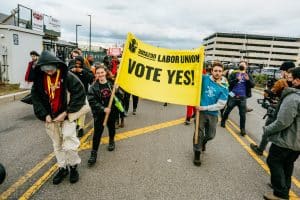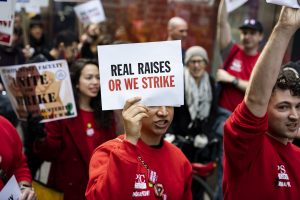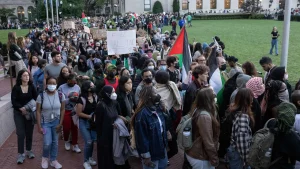The unionization effort at Amazon’s warehouse in Bessemer, Alabama did not produce enough votes for victory — although the Retail, Wholesale and Department Store Union (RWDSU) is rightfully contesting the outcome over the company’s illegal interference. The bosses have spent millions to keep unions out of U.S. Amazon facilities, and Bessemer was no exception. This time, the company added every form of intimidation it could think of, like getting the government to install a new mailbox right outside the doors and mailing instructions to workers on how to vote no. Making it look as if the company would itself be collecting the mail-in ballots was part of an overall strategy that even included offering buyout bribes to get workers to quit so their votes wouldn’t count.
The company may have won this single battle, for now, but Amazon is fighting in a war. It’s a war to reverse the devastating blows to unions in the United States that have unfolded over decades of neoliberalism. That’s the weakened position from which the Bessemer workers and all union organizing efforts today must fight.
But it’s a war workers can win.
On Wednesday morning, a few dozen workers staged a walkout at Amazon’s giant distribution center in Gage Park on the southwest side of Chicago, demanding better working conditions. They were joined by other workers who weren’t scheduled to work at that time — a clear indication of some coordination.
Rakyle Johnson live streamed the walkout. He’s from Amazonians United Chicagoland, and said, “We’re tired of being used. We work so hard. We give so much to our company … but they don’t give anything back.”
Left Voice is hosting a panel with a Bessemer Amazon worker and Robin D.G. Kelly, author of Hammer and Hoe to discuss the results of the unionization vote. Sign up here. RSVP to the Facebook event here.
It was the second demonstration by workers at the facility this month. On April 1, the same organization protested the new “megacycle” shifts that have them working 10.5 hours, from 1:20 a.m. to 11:50 a.m. They demanded a $2/hour raise, accommodations for those who need to get home to care for children, ride-share trips to and from the facility, and full breaks without managers cutting them short.
Militant actions like that suggest a unionization drive in Chicago could be on the horizon. How many battles will Amazon have to wage at the same time, in this expanding war?
As Left Voice reported last month, the Bessemer struggle has opened the floodgates. We now know of unionization efforts in Baltimore, New Orleans, Portland (Oregon), Denver, and Southern California, where workers have reached out to the same RWDSU that sought certification in Bessemer. We know that the Teamsters have also begun an organizing drive at two Amazon locations in Iowa. There are surely others that have not yet become publicly known.
Amazon’s essential workers have toiled throughout the pandemic and watched the fortune of owner Jeff Bezos rise exponentially. Meanwhile, they suffered through coronavirus outbreaks in their facilities. Some got a hazard “raise” that was short lived and insufficient. With kids out of school, childcare facilities closed or financially out of reach, and all the other exigencies of working-class life — especially those with precarious warehouse and delivery jobs — that money needed to be much greater, and permanent.
The pandemic has revealed that income and wealth inequality in this country have reached levels that at other points in history, in other places, have spurred the working class to throw off the shackles of the capitalist system of exploitation. The bosses are well aware of the tightrope they are walking.
Some Lessons from History
How will Amazon workers win? A look into the rich history of the U.S. labor movement provides some important lessons. And while the specific time and place of any workers’ struggle certainly matters, there are some immutable truths that have emerged over the past century and longer about what wins in a fight with the bosses. Workers can be more or less combative; it is their own choice and that of their leaders.
It is especially instructive to look at the 1930s, when some of the most bitterly fought struggles for unionization took place in this country. It was a time when the United Auto Workers Union, the United Steel Workers Union, and other industrial units taught the capitalists a lesson about the power of a united working class unlike any they had ever been given before in the United States.
In the 1930s, this country’s great industrial unions were built not through certification elections but by direct, militant class action. The great strikes of the decade were initially battles for union recognition.
Here’s just a taste of how the power of a united working class rocked one city — Akron, Ohio — where workers in 1935 created the United Rubber Workers, which very soon had 29 union locals in the area. The next year, workers at the Goodyear plant went out on strike to compel the bosses to recognize the union. A 1936 article in the New Militant by Farrell Dobbs, a Trotskyist who had two years earlier been one of the central leaders of the Minneapolis Teamsters strike that is a touchstone in American labor history, spelled out how the union waged its battle. He raises three key points.
On Tuesday morning, February 25, the embattled workers, picketing in violation of a court injunction, calculated to destroy their strength, faced down an army of police and special deputies sent out to enforce the injunction. The picket line holds solid with a picket post at each of the 168 gates of the plant.
The Akron workers refused to follow the “rules” established by the state, in this case ignoring a court injunction against picketing. This was possible because they amassed sufficient numbers of people to face down the security forces of the company and the state. It was mass action at the point of production.
Around the eleven mile fighting front the slogan is: “Nobody goes in the plant.” Those hard bitten cynics who say that the American worker will not fight shall have to change their minds after this forceful demonstration.
The rubber workers shut down the facility. Their position was clear: no work and no profits until our union is recognized, the bosses bargain with us, and our demands are met.
A second and larger assembly place is needed for large gatherings of the strikers and, of equal importance, so that workers from the other rubber plants and all other Akron workers may come to the proper place to get correct information regarding the strike and to get instructions as to how they may best assist. … The rubber workers do want the other workers to know about their fight and they want their support.
The rubber workers needed a larger headquarters to organize and wage their labor battle because they were not fighting on their own — they were involving other workers and the Akron community.
These three key points from Akron suggest lessons for Bessemer and workers in any other warehouse who plan to face the Amazon behemoth.
Waging a More Militant Battle
These days, union recognition is almost always won (or lost) by means of elections managed by a branch of the U.S. government, with the agreement of the union bureaucracies. Putting faith in the bosses’ own politicians to secure “fair” elections and secure union rights reshapes what were once militant — and mass — workers’ struggles into electoral campaigns. Canvassing door-to-door — as the RWDSU and its allies did in the Bessemer campaign — has its place, especially if it flows from rank-and-file committees that organize and lead it, but it cannot be a substitute for mass meetings and other activities that build a unified response by the workers in a facility. An “endorsement” of a yes vote for the union from this or that capitalist politician is seen by these bureaucrats as having more value and importance than winning the active participation of the entire working class to force the bosses to recognize the union.
And all the while, everyone keeps working over a very long voting period. The bosses keep making profits they can use to defeat the union in the vote. The drawn-out time lets them send multiple anti-union messages to workers, hold anti-union meetings, enact restrictions that keep workers from talking with each other in the facility, and so on — all things Amazon did in Bessemer.
Imagine a different scenario in Bessemer than what we just saw play out over many months. What if rank-and-file workers had taken control of the organizing effort, building their own committees to organize every aspect of the battle instead of leaving it all up to the union bureaucrats? What if rank-and-file workers had insisted not only on a union certification election, but had organized to back up that effort by shutting down the facility until their union was recognized? Imagine if the workers in Bessemer were meeting and thinking through how to wage their struggle rather than relying on the business unionism of the RWDSU. Rank-and-file committees might have issued a call to workers everywhere — employed and unemployed, unionized and unorganized — to come to Alabama to confront the special deputies dispatched to the fulfillment center and the thug security guards Amazon hired — something the RWDSU leadership did not do.
Rank-and-file committees could have organized and held mass rallies throughout the area — and called on workers from other unions to join them — where they explained what unions are, why they’re important, and the tremendous gains they’ve won for workers in this country. Amazon was very successful in spreading lies about unions to workers in the facility, and post-election reporting suggests that many Bessemer workers — even after the long campaign for certification — had not yet heard a compelling reason from the union to vote yes. The union did not do enough to counter Amazon’s lies in a way that would reach the mass of workers.
Mobilizing the Community and Other Unions
Bessemer is a 20-minute trip from Birmingham, a city with a 70-percent Black population. The workforce in Amazon’s Bessemer facility is an estimated 85-percent Black. Imagine if Birmingham’s Black community had been mobilized to make that short trip for a show of force at the Amazon facility. The union did have activists from the Black Lives Matter movement at the warehouse doors — a recognition that the fight at Amazon is a fight for racial justice, too, and that unions and BLM are natural allies. But what if the union and BLM had worked together to bring to Bessemer the forces BLM is able to bring out in Birmingham’s streets?
Union bureaucrats today tend to view their organizing efforts far too narrowly — setting them up to lose. They don’t mobilize allies from the working class, because they don’t see their fight in class terms. That’s an important element of early union-building that needs to be recaptured. In 1934 in Toledo, Ohio, at the height of the Depression, the United Auto Workers organized the Auto-Lite factory after battling the cops and the National Guard. Who was in the front lines of that fight in the streets while the workers occupied the plant? It was the city’s jobless, organized in the Lucas County Unemployed League. They were the natural allies of the striking workers, and they bled in solidarity.
The RWDSU never mobilized at that sort of level. Yes, the union sent lots of people around the Bessemer area to canvass and encourage a yes vote. But once the union accepted the election framework as spelled out by the government, it situated itself firmly within the business unionism comfort zone. What might workers have done differently?
The Amazon organizing drive in Alabama was an opportunity to engage workers across the United States, and do more than the relatively small local solidarity rallies that took place in various parts of the country. These were sometimes at Amazon facilities, but more often at Whole Foods grocery stores (also owned by Amazon). They involved some unionized workers, but not enough.
You might be interested in: Unions in the Biden Era
The Bessemer fight was a time for the entire union movement to flex its muscles. Mass rallies could have been held, with widespread union involvement — and done safely, even during the pandemic. Unionists could have been dispatched to Bessemer by their unions — it would have been a good investment of union dues — to talk to Amazon workers and counter the company’s lies about what unions are all about. Imagine railroad workers from Kansas City talking to Amazon workers outside the facility, explaining how their union not only makes economic gains for the workers in their yard but also what it means to be in an organization that is based on the very notion that workers constitute a class, and that the bosses are a class enemy.
Imagine unionists from all around the country actively demonstrating that they have the back of every Amazon worker fighting for a union. The RWDSU alone organizes 100,000 workers throughout the United States — where was the mobilization of the union’s own rank and file? That’s a strategy for winning a war. Unfortunately, it’s not the strategy of the union bureaucracies — which is why rank-and-file union members need to make it their strategy.
This may sound like pie in the sky, but it’s how the labor movement — once the strongest in the world — was built in this country. Workers are a class. Workers do have a common enemy in the bosses and their capitalist system, which survives only through exploitation.
As Farrell Dobbs wrote in the article about Akron, “The almost unbelievable resourcefulness and the splendid courage and determination shown by the rubber workers proved beyond the question of a doubt that the strength of a giant lies smoldering within the ranks of the American workers in the basic industries.” It’s high time to unleash that giant.
“Forget undemocratic business unions,” tweeted Amazonians United Chicagoland on March 20. As inequality expands and the capitalist crisis persists, the bosses will try to make us pay for their troubles. Union victories will be won not by putting more faith in capitalism’s politicians, or pressuring them for “better” laws that keep our class tied to institutions of capitalist rule. We have to fit with every bit of our strength. Our workplace organizations — those that already exist, and those we need to build — must be part of that fight.











